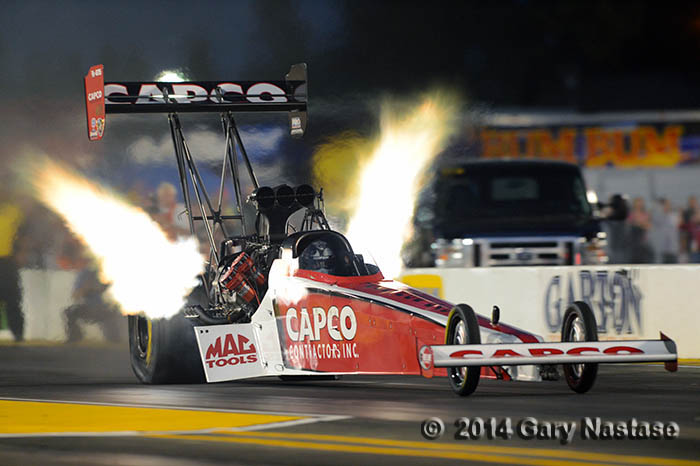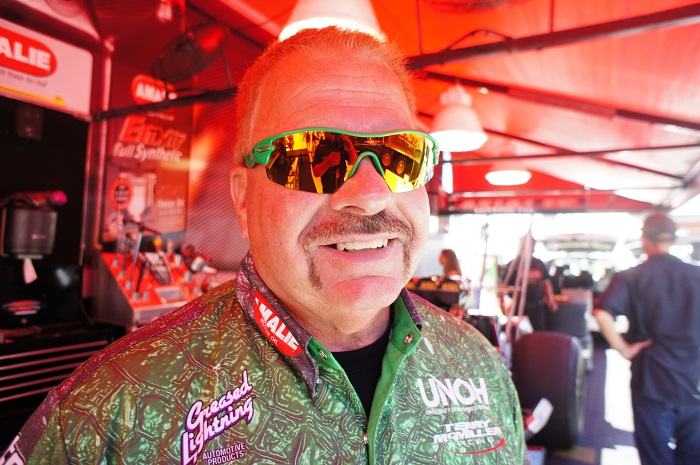SOME RACERS WOULD LOVE TO SEE DOWNSIZED NHRA SCHEDULE
 Terry McMillen and Steve Torrence have three prominent things in common. They both race Top Fuel dragsters and love the experience. They also wish there were fewer races than the current 24-event tour.
Terry McMillen and Steve Torrence have three prominent things in common. They both race Top Fuel dragsters and love the experience. They also wish there were fewer races than the current 24-event tour.
Torrence, of Kilgore, Texas, races a fuel dragster sponsored by his family-owned CAPCO Contractors business and works to keep a competitive budget while dueling with higher financed multi-car teams.
 Terry McMillen and Steve Torrence have three prominent things in common. They both race Top Fuel dragsters and love the experience. They also wish there were fewer races than the current 24-event tour.
Terry McMillen and Steve Torrence have three prominent things in common. They both race Top Fuel dragsters and love the experience. They also wish there were fewer races than the current 24-event tour.
Torrence, of Kilgore, Texas, races a fuel dragster sponsored by his family-owned CAPCO Contractors business and works to keep a competitive budget while dueling with higher financed multi-car teams.
McMillen drives the Amalie Oil Top Fuel dragster, and while his sponsorship with the Tampa, Fla-based oil manufacturer provides modest working capital, a shorter schedule would allow him to get a different kind of "bang" for his buck rather than pushing his parts just to keep up.
"24 races in my opinion is way too many races,' said Torrence.”It’s grueling on not only us as drivers but the crew guys. They’re out here on the road for ten weeks out of 12 weeks of racing or in 12 weeks you’ve got 10 races, and you’ve got 3 in a row, 4 in a row, 3 in a row. It’s too grueling. The season is too long.
"We start in February and we go to November. The off season is jam-packed trying to get ready to go because you’re strung out so much through the year. I would really like to see a 16-18 race season that started a little later and ended a little sooner."
The NHRA ran a 15-race schedule last in 1987 and expanded to 17 in 1988; by 1990 the schedule had grown to 19. Last season, the NHRA expanded to 24-events by adding the NHRA New England Nationals in Epping, NH.
The NHRA's most grueling challenge was once the Western Swing; a three-race consecutive tour beginning in Denver, Co., then moving to Sonoma, Ca., before finishing up in Seattle, Wash.
The current schedule features three consecutive weekend races in May, with four in June - July. The two stretches account for seven races in eight weekends. The Countdown features another four in a row stretch.
 Top Fuel racer Terry McMillen would be open to seeing the NHRA adopt a points program where racers could pick their best races to claim points similar to the sportsman divisions. "Financially it’s a big deal," Torrence said of the consecutive race weekends. "You’re incurring hotel expenses for weeks on end instead of a few days at the race and then the guys get to go back to the shop. We’ve always done the Western Swing but now we’ve got the “Eastern Swing” where you’ve got four weeks straight where these guys are basically staying in hotels at $120 a night at 10 rooms every week.
Top Fuel racer Terry McMillen would be open to seeing the NHRA adopt a points program where racers could pick their best races to claim points similar to the sportsman divisions. "Financially it’s a big deal," Torrence said of the consecutive race weekends. "You’re incurring hotel expenses for weeks on end instead of a few days at the race and then the guys get to go back to the shop. We’ve always done the Western Swing but now we’ve got the “Eastern Swing” where you’ve got four weeks straight where these guys are basically staying in hotels at $120 a night at 10 rooms every week.
"It’s not cheap and logistically we’re crisscrossing the country. We got too many races that are in no kind of fashion laid out to benefit the race teams or anybody," said Torrence. "We race in Vegas, we go to Charlotte. We race in Phoenix, and we go to Gainesville. We go back to Houston, and we go back to Atlanta. What is the reason for that?"
McMillen said the NHRA needs the racers and vice versa. The larger schedule and consecutive race schedules force the smaller teams to scramble just to keep up, all the while putting a burden on them just to be a part of the game.
"NHRA can’t run without racers and we can’t run without the NHRA." McMillen said. "Corporate America is no different than they are: the big dollars aren’t there like they used to be, so we’ve got to figure out how to be more efficient with what we do. I think we have the best sport in the world and certainly with fans being able to come up and talk to drivers and the crew, it’s the best place to be. It’s our locker room, and you can come in. We have the tools, and we have the product we’ve just got to figure out how to make it work, come together between the two ends."
NHRA officials introduced the Countdown to the Championship in 2007, as a means of creating championship excitement for many point battles which were concluded well before the final event on the tour. One of the knocks on the original proposal was a driver could clinch their playoff position early on and then sit out the races.
While the format has enabled drivers who missed races at the early part of the season to get back into contention, Pro Stock point leader Erica Enders-Stevens is sitting out two-thirds of the Western Swing, and can still return in Brainerd with her point lead intact.
Torrence has said if he were in the same position he'd do the same thing as Enders-Stevens. He believes the larger schedule and consecutive race weekends dilute the quality of the product.
"A shorter schedule definitely would concentrate the races more," Torrence said. "We race twice in Vegas, we race twice in Charlotte, and I’m sure that if you talked to the fans in that area they may not make both races ... they may only make one race or the other and for some of the fans, this is more often than not a family vacation for some of the spectators that come out so when they come out and see one race early in the year they’re probably going to pick or choose whether they’re going to go the four-wide or the regular race at the end of the season as opposed to actually making both races.
"I don’t know if you don’t dilute your attendance a little bit per se as opposed to shortening the schedule up and trying to concentrate more on attracting fans in that race area as opposed to having one over here and one over there and you get to pick and getting half the crowd at one race."
McMillen said he'd be in favor of a point system where racers can claim certain races for points, and race others for sponsorship commitments.
"You know what I would like to see?" McMillen asked. "Maybe we could, instead of claiming all races, select 16 races out of 24 to claim points in. That way you didn’t have to go to all of them but yet we could. The West Coast guys could run more of the West Coast stuff. The Midwest guys could run more of the Midwest, and certainly there would be some cross-pollination in there but trying to make it work within 16 races even though there are 24, and I think right now until the economy gets stimulated again I think that's the only tool to help all of us continue to grow the business right now."
The act of cutting and pasting articles from this publication to a message board is a clear copyright violation as is pulling photos to post on social media sites. All articles and photography published in CompetitionPlus.com are protected by United States of America and International copyright laws unless mentioned otherwise. The content on this website is intended for the private use of the reader and may not be published or reposted in any form without the prior written consent of CompetitionPlus.com.





































